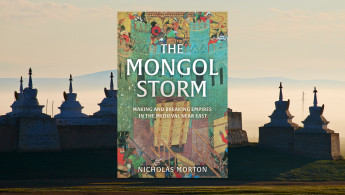How the 'Mongol Storm' swept across empires in the medieval Near East
Nicholas Morton’s The Mongol Storm: Making and Breaking Empires in the Medieval Near East is a thrilling and exhilarating exploration of how politics in the Middle East in the 13th century changed with the arrival of the Mongols.
The Near East was divided between different dynasties and rulers all of whom were governing over a diverse population in which 50% were either Muslim or Christian with the rest belonging to other faiths, meanwhile there were a series of wars being fought called the Crusades. All of this was at the dawn of the Mongol invasions in 1218.
The success of the Mongols in the Far East was causing tension in the Near East as Genghis Khan united Mongolian tribes and was empire-building. The Persian Khwarazmian empire eyed the Mongol advances with suspicion, however, there were hopes for peaceful co-existence as Khan was interested in trade with the Persians.
"The Mongol Storm takes us on a journey through the pre and post-Mongol Near East and how the conquests changed both sides"
Things might have turned out differently had the Khwarazmian Sultan not ordered the execution of Mongol merchants after an incident took place.
Worse still, wanting to know why the executions happened, Genghis Khan sent an envoy to the Sultan who the Sultan also executed. The onslaught unleashed by the Mongols would see the Central Asian part of the Khwarazmian empire fall.
“By the 1230s, the Mongols' grandiose objectives had fully crystallized. Their task was to conquer and subdue the entire planet,” such was the scale of their victories and conquests across the Near East and beyond, they started to believe the whole world was there for the taking.
While the Mongols had shamanistic beliefs, they would encounter Muslim dynasties who originated from Central Asia and had similar beliefs to themselves. Seljuk Turks in particular kept many of their pre-Islamic Central Asian customs, “during the First Crusade (1095-1099), one Frankish author noticed that some Turks still buried their dead with weapons, money, and horses-grave goods intended to equip a warrior in the afterlife.” This was also a Mongol practice.
|
The invasions would change the Near East but also change the Mongols themselves who now had to adapt to a new geopolitical environment.
The increased size in territories controlled by the Mongols would lead to power rivalries within the Mongol Empire. Violent purges took place between different claimants to leadership in the western half of the empire, but despite these divisions, they did not impact their ability to keep on expanding.
When the Mongol consequences began military commanders would demand irregular payments from conquered populations, but by the 1240s, the need for a more sustainable form of government was recognised. “The basic principle of Mongol governance was that once they subdued an area, they would subsequently introduce the administrative machinery of Mongol governance.
They recognised the need to establish systems of taxation, trade, and regional governance so that they could gather all the money and resources they needed from subjugated communities.” However, this transition was not always a smooth one and tensions between civil administrators, military commanders and imperial families over who gets what from the new system would lead to constant disruptions to trade networks and governance for Mongol territories in the Near East.
Despite this, regional powers and newly conquered subjects sought to win the Mongols' favour. Some Christian clients and subjects hoped to convert the Mongols to Christianity, and one Armenian hermit promised the Khan that if he were to adopt Christianity, the pope would submit to him. Georgian and Armenian Christians would seek favour from the Mongols by becoming enthusiastic supporters of the empire in order to get concessions from them.
|
The Mongol Storm takes us on a journey through the pre and post-Mongol Near East and how the conquests changed both sides. Certain belief structures were challenged. For example in Mongol beliefs, washing in running water during spring and summer was forbidden due to fears it would cause thunderstorms.
This caused issues when first encountering Muslim subjects who routinely performed ablutions before prayer, in one account the Great Khan Ogobei was out hunting with his brother and they saw a Muslim washing himself before prayer. The Khan’s brother became enraged and demanded his execution, but the Great Khan decided to spare the Muslim by throwing a bar of silver into the water and claimed he wasn’t washing but trying to save the precious metal.
Encountering new beliefs and ideas unknown in the homeland, the Near East radically shifted the belief structures of the conquerors.
Nicholas Morton’s compelling narrative also highlights something else that is important, the Crusades are happening at the same time, and interactions between Mongol, Crusader and Muslim states are a key part of this period’s history.
Often popular works talk about the Crusades or the Mongols in the Near East, but rarely about how they interacted with each other. The Mongol Storm is a much-needed intervention that tells this complex story in an easy-to-follow way.
Usman Butt is a multimedia television researcher, filmmaker and writer based in London. Usman read International Relations and Arabic Language at the University of Westminster and completed a Master of Arts in Palestine Studies at the University of Exeter.
Follow him on Twitter: @TheUsmanButt


![President Pezeshkian has denounced Israel's attacks on Lebanon [Getty]](/sites/default/files/styles/image_684x385/public/2173482924.jpeg?h=a5f2f23a&itok=q3evVtko)



 Follow the Middle East's top stories in English at The New Arab on Google News
Follow the Middle East's top stories in English at The New Arab on Google News


